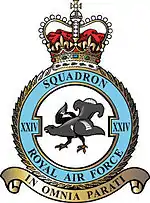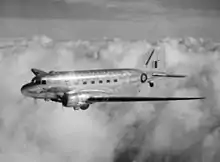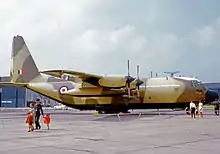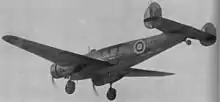No. 24 Squadron RAF
No. 24 Squadron (also known as No. XXIV Squadron) of the Royal Air Force is the Air Mobility Operational Conversion Unit (AMOCU). Based at RAF Brize Norton in Oxfordshire, 24 Squadron is responsible for aircrew training on C-130J Hercules, A400M Atlas and C17 Globemaster. The Sqn also delivers engineer training for C130J Hercules, A400M Atlas and C17 Globemaster.
| No. XXIV Squadron RAF | |
|---|---|
 | |
| Active | 21 September 1915 – present |
| Country | |
| Branch | |
| Type | Operational Conversion Unit |
| Role | Air mobility fleet training |
| Part of | No. 2 Group RAF |
| Home station | RAF Brize Norton |
| Motto(s) | In omnia parati (Latin for 'Prepared for all things/Ready for anything')[1] |
| Aircraft | |
| Battle honours |
|
| Commanders | |
| Current commander | Wing Commander A McIntyre |
| Notable commanders | Major L G Hawker |
| Insignia | |
| Squadron badge heraldry | A blackcock, selected because of its speed and strength on the wing, the cock is in fighting attitude to suggest the squadron’s ability to turn itself into a war fighting unit at short notice, despite a peacetime training role. Approved by HM King George VI in June 1937. |
History
Fighter squadron (1915–1919)
The squadron was founded as No. 24 Squadron, Royal Flying Corps on 1 September 1915 at Hounslow Heath Aerodrome.[2] It arrived in France equipped with D.H.2 fighters in February 1916.[2] The DH.2 came with a reputation for spinning because it had a rotary engine "pushing" it, but after Officer Commanding Major Lanoe Hawker demonstrated the recently discovered procedures for pulling out of a spin, the squadron's pilots came to appreciate the type's maneuverability.[3]
By early 1917 the DH.2 was outclassed and they were replaced by the Airco DH.5. The DH.5 did not prove suitable as a fighter but the squadron used it in a ground-attack role. One of the first actions was during the Battle of Messines and later in the Battle of Cambrai. The DH.5 was phased out of operations and the squadron were given the SE.5a in December 1917.[4] After a few months in the ground-attack role the squadron returned to air combat operations. By October 1918 the squadron had destroyed 200 enemy aircraft. With the armistice the squadron returned to England and was disbanded in February 1919.[4] During the course of its wartime existence, it had 33 flying aces among its ranks, including
- Tom Hazell
- Ian Donald Roy McDonald
- Horace Barton
- Andrew Cowper
- William C. Lambert
- George McElroy
- Herbert Richardson
- Ronald T. Mark
- Patrick Anthony Langan-Byrne
- Alan Wilkinson
- Selden Long
- Reuben Hammersley
- John Oliver Andrews
- Bernard Paul Gascoigne Beanlands
- Alfred John Brown
- Conway Farrell
- George Buchanan Foster
- Arthur Gerald Knight
- Cyril Lowe
- Peter MacDougall
- Harold Redler
- Hilbert Bair
- Stanley Cockerell
- Sidney Cowan
- John Daley
- Henry Evans
- Thomas M. Harries
- George Owen Johnson
- Walter H. Longton and
- Henry Woollett.[5]
As a VIP transport squadron (1920–1968)

On 1 February 1920 the squadron was re-formed at RAF Kenley as a communications and training squadron.[2] During the General Strike of 1926, because of the lack of a postal services, the squadron was used to deliver government dispatches around the country.[2]
Following the outbreak of the Second World War the squadron acquired more civil airliners which were impressed for wartime service. It provided a detachment in France to run a courier services, but with the withdrawal of British troops it was soon used to evacuate men back to England. Former British Airways and Imperial Airways aircraft were put to use on a network of communications flights including trips to Gibraltar and later Malta.[2]
The squadron had grown into a large organisation not only with a network of routes around the United Kingdom and eventually extended to India. It also operated VIP transports including Sir Winston Churchill's personal aircraft. It was decided to break the squadron up, the internal communication flight became 510 Squadron in October 1942.[6] In June 1943 a second squadron, No. 512, equipped with Douglas Dakotas was split off from No 24.[6] This left 24 Squadron to concentrate on the long distance routes using the Avro York.[2]

After many years the squadron had to leave RAF Hendon in February 1946 as the airfield was now too small to operate the larger Avro Yorks and Avro Lancastrians.[2] The squadron was also designated a Commonwealth squadron with crews from various Commonwealth countries joining the squadron strength.[2]
As a Transport Command Squadron (1968–2013)
In 1968 the squadron moved from RAF Colerne to RAF Lyneham and re-equipped with the Lockheed Hercules. The squadron re-equipped with the new generation Hercules C.4 and C.5 RAF designation for the C-130J-30 and C-130J respectively in 2002. It celebrated 40 years of Hercules operation in 2008 and remained at Lyneham until 2011 when the squadron relocated to RAF Brize Norton.[7]
As a Training Squadron (2013–present)
In 2013, 24 Squadron started its transition from a front line C130J Hercules Squadron to become the Air Mobility Operational Conversion Unit.[2] This transition brigaded the majority of flying and engineer training within the Air Mobility Force under one specialist training unit. 24 Squadron is currently responsible for the provision of training to aircrews flying the C130J Hercules and A400M Atlas aircraft; in addition 24 Squadron's Maintenance Training School is responsible for training engineers to maintain the C130J Hercules, A400M Atlas and C17 Globemaster aircraft. As a Central Flying School accredited training establishment, 24 Squadron is the professional training body for the Air Mobility Force delivering flying training for the C130J Hercules, A400M Atlas and C17 Globemaster as well as engineering training for the C130J Hercules, A400M Atlas and C17 Globemaster. The Squadron also oversees Aircrew Instructor Development for the Air Mobility Force, delivering initial aircrew instructor courses. [8]
Aircraft operated

- 1915-1915 Curtiss JN-4
- 1915-1915 Caudron G.III
- 1915-1915 Avro 504
- 1915-1915 RAF BE.2C
- 1915-1915 Bleriot IX
- 1915-1915 Bristol Scout
- 1915-1915 Maurice Farman Longhorn
- 1915-1915 Maurice Farman Shorthorn
- 1915–1916 Vickers FB.5
- 1916–1917 Airco DH.2
- 1917–1918 Airco DH.5
- 1917–1919 RAF SE.5A
- 1920–1930 Bristol Fighter
- 1920–1927 de Havilland DH.9A
- 1927–1933 Avro 504N
- 1927–1933 de Havilland Moth
- 1927–1933 Westland Wapiti
- 1927–1933 Fairey IIIF
- 1930–1933 Hawker Tomtit
- 1931–1932 Avro Tutor
- 1933–1941 Hawker Hart
- 1933–1938 de Havilland Tiger Moth
- 1933–1938 Hawker Audax
- 1933–1944 de Havilland Dragon Rapide and Dominie
- 1937–1938 Miles Nighthawk
- 1937–1943 de Havilland Express
- 1938–1940 Miles Magister
- 1938-1938 Avro Anson I
- 1938–1944 Miles Mentor
- 1938–1942 Percival Vega Gull
- 1939–1940 de Havilland Leopard Moth
- 1939–1940 de Havilland Fox Moth
- 1939–1941 de Havilland Dragon
- 1939–1942 Lockheed 10 Electra
- 1939–1942 Percival Q.6
- 1939–1940 de Havilland Puss Moth
- 1939–1944 de Havilland Flamingo
- 1939–1940 Airspeed Envoy
- 1940–1942 Miles Whitney Straight
- 1940-1940 Heston Phoenix
- 1940-1940 Savoia-Marchetti S.73
- 1940-1940 Douglas DC-3
- 1940-1940 Avro Anson I
- 1940-1940 Armstrong Whitworth Ensign
- 1940–1942 de Havilland Hornet Moth
- 1940–1944 Airspeed Oxford
- 1941–1943 Stinson Reliant
- 1941–1942 General Aircraft Cygnet
- 1941–1942 Blackburn Botha
- 1941–1945 Beech 17 Traveler
- 1941-1941 Parnall Heck III
- 1941–1942 de Havilland Leopard Moth
- 1941–1943 Lockheed Hudson I
- 1941–1942 Lockheed Hudson II
- 1942-1942 Messerschmitt Bf 108
- 1942–1943 Fokker F.XXII
- 1942–1943 Foster Wikner Wicko
- 1942-1942 Lockheed Hudson IV
- 1942–1945 Lockheed Hudson III
- 1942-1942 Heston Phoenix
- 1942–1943 Lockheed Hudson VI
- 1942–1944 Lockheed 12
- 1942–1943 Percival Proctor
- 1943–1944 Grumman Goose
- 1943–1944 Vickers Wellington XVI
- 1943–1944 Avro York I
- 1943–1952 Douglas Dakota
- 1944-1944 Avro Anson XX
- 1944–1945 Douglas Skymaster
- 1946–1949 Avro Lancastrian C2
- 1946–1951 Avro York C1
- 1950-1950 Vickers Valetta C1
- 1950-1950 Handley Page Hastings C1
- 1951–1968 Handley Page Hastings C2
- 1951–1968 Handley Page Hastings C4
- 1968–2000 Lockheed Hercules C130K
- 2000–present Lockheed Hercules C130J
- 2013-present Airbus A400M Atlas
Commanding officers
The following officers have held command of No. 24 Squadron:[9]
- 1 September 1915, Captain A G Moore
- 29 September 1915, Major L G Hawker
- 29 November 1916, Major C E Rabagliati
- 23 March 1917, Major A G Moore
- 22 August 1917, Major J G Swart
- 2 February 1918, Major V A H Robeson
- 1 April 1920, Squadron Leader E H Johnston
- 23 October 1922, Squadron Leader O T Boyd
- 22 October 1923, Squadron Leader R S Maxwell
- 27 August 1925, Squadron Leader W H L O'Neill
- 20 September 1927, Squadron Leader S N Cole
- 20 March 1929, Squadron Leader D S Don
- 3 October 1931, Squadron Leader J Whitford
- 1 December 1935, Squadron Leader H K Goode
- June 1939, Wing Commander J Anderson
- October 1939, Wing Commander H K Goode
- April 1941, Wing Commander H G Lee
- June 1941, Wing Commander P M W Wright
- June 1942, Wing Commander H B Collins
- September 1944, Wing Commander T H Archbell
- October 1945, Wing Commander E L A Walter
- September 1946, Wing Commander C W K Nicholls
- March 1948, Wing Commander P H Lombard
- March 1950, Wing Commander C F Read (RAAF)
- December 1950, Squadron Leader H A Nash
- October 1951, Major J N Robbs (SAAF)
- October 1953, Squadron Leader J L Kerr
- September 1955, Squadron Leader R B Bolt (RNZAF)
- February 1957, Squadron Leader M M Mair
- October 1957, Wing Commander D W Hitchins (RAAF)
- October 1959, Wing Commander H D Archer
- November 1961, Wing Commander R B Sillars
- November 1963, Wing Commander R T Saunders
- January 1966, Wing Commander G Moss
- January 1968, Wing Commander J E H Tetley
- July 1970, Wing Commander R D Bates
- July 1972, Wing Commander M J Hardy
- July 1974, Wing Commander C E Evans
- February 1976, Wing Commander M C A Davis
- August 1978, Wing Commander K Chapman
- October 1980, Wing Commander D R Jones
- March 1983, Wing Commander C J M Carrington
- June 1985, Wing Commander R M Peach
- December 1987, Wing Commander D B Farquhar
- April 1990, Wing Commander R D Iredale
- October 1992, Wing Commander M D Stringer
- June 1995, Wing Commander R M Bailey
- April 1998, Wing Commander P N Oborn CBE
- August 2000, Squadron Leader G C Cook
- December 2000, Wing Commander R Hobson
- June 2003, Wing Commander K Groves
- October 2005, Squadron Leader S K Marston
- December 2005, Wing Commander D Turnbull
- June 2008, Wing Commander A Bacon
- November 2010 Wing Commander P G Cochrane
- February 2011 Wing Commander T Jones
- December 2012 Wing Commander D James
- January 2015 Wing Commander D Rawlins
- March 2017 Wing Commander G Burdett
- October 2019 Wing Commander A McIntyre
See also
- List of RAF squadrons
References
- Citations
- Pine, L.G. (1983). A dictionary of mottoes (1 ed.). London: Routledge & Kegan Paul. p. 110. ISBN 0-7100-9339-X.
- "No 21 - 25 Squadron Histories". Air of Authority - A History of RAF Organisation. Retrieved 20 June 2019.
- Pusher Aces of World War 1. pp. 28–29.
- Rawlings 1972, p.144.
- "Henry Woollett". Archived from the original on 25 May 2016. Retrieved 26 April 2016. Retrieved 28 January 2010.
- Rawlings 1972, p. 146.
- "24 Squadron" Archived 4 July 2014 at the Wayback Machine. Royal Air Force. Retrieved 5 July 2011.
- "14 Squadron". RAF. Retrieved 20 June 2019.
- "24 Squadron Commanding Officers". 24 Squadron Association. 2015. Archived from the original on 7 February 2015. Retrieved 7 February 2015.
- Bibliography
- The Illustrated Encyclopedia of Aircraft (Part Work 1982–1985), Orbis Publishing.
- Jefford, G. G. RAF Squadrons, second edition 2001, Airlife Publishing, UK, ISBN 1-84037-141-2.
- Rawlings, J. D. R. "History of No. 24 Squadron". Air Pictorial, April 1972, Vol.34 No.4. pp. 144–147.